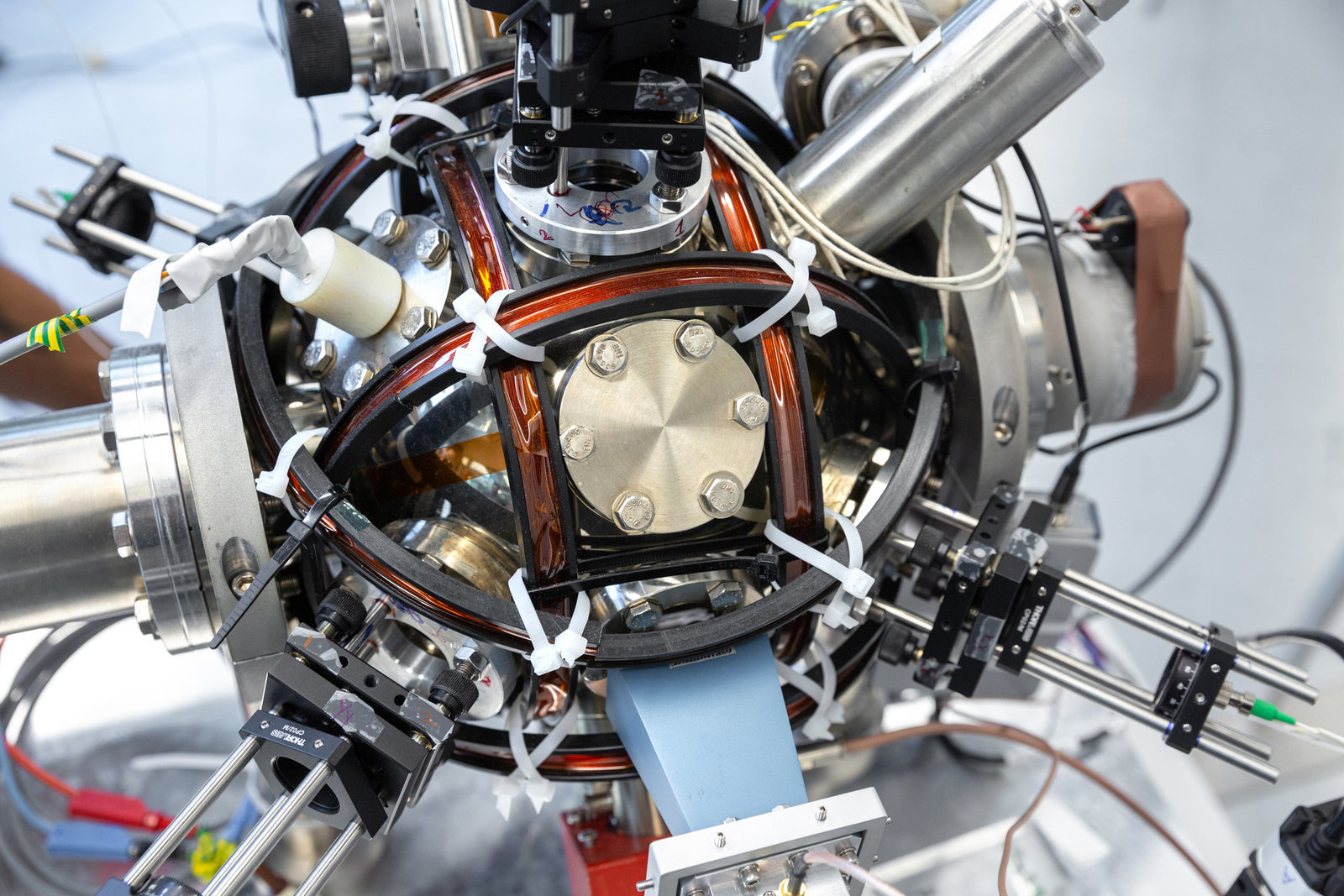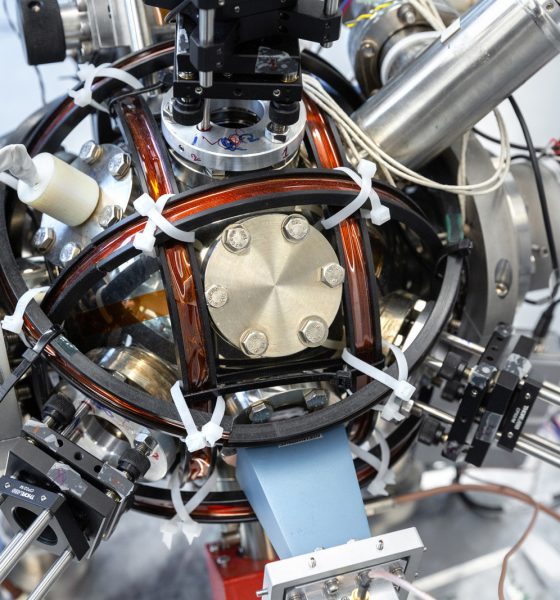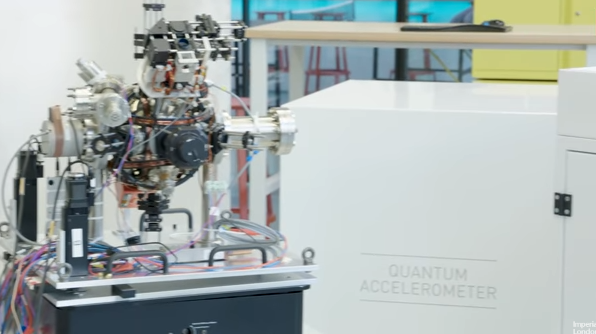

News
Quantum ‘compass’ technology aids in navigation without use of GPS satellites
Scientists from Imperial College London and M Squared, a photonics and quantum technology company, have created a portable quantum accelerometer which enables location tracking without the aid of GPS satellites. As demonstrated at the National Quantum Technologies Showcase 2018 in London, the device utilizes ultra-cooled atoms and lasers to measure position with precision made possible by quantum mechanics. The system is currently designed to be used for navigating large vehicles such as ships and trains, but smaller-scale devices will be available as the technology develops.
Quantum accelerator in the lab. | Credit: Imperial College London
The reliance on global navigation satellite systems such as GPS has a few significant shortcomings that the quantum accelerometer would overcome. Satellite signals can be blocked or jammed, interfering with the systems that rely on the data being provided. Threats such as electromagnetic pulse (EMP) attacks on a massive scale, now closer to reality with nuclear capability developments around the world, would cripple any technology relying on satellite systems.
The financial burden of GPS failure is also a serious consideration driving the innovation behind this device. In M Squared’s press release announcement, it was estimated that each day without GPS services in the United Kingdom would cost the country 1 billion pounds. Since it’s a self-contained system not reliant on external signals, a quantum accelerometer would not be at risk for these types of security or financial fallouts.

A close up of the quantum accelerator. | Credit: Imperial College London
Even without the consideration of electronic attacks and satellite failures, a much smaller version of this technology could overcome day-to-day problems with regular GPS use. Anyone who has ever used a map application in a city environment has likely experienced blockages from the buildings disrupting satellite signals. A quantum accelerator would calculate its position based on its high precision velocity measurements rather than GPS information, thus eliminating never-ending “recalculating” type errors that current mapping devices are prone to receive.
General accelerometers are already found in common devices like cell phones and video game controllers. Overall, they function by calculating changes in the velocity of an object (phone, controller, etc.) and that data is used for whatever its intended purpose. For location-driven applications, however, the measured position loses accuracy without feedback from external sources such as GPS. For example, after a few street turns (or less), a mapping application would need to confer with a satellite to recalculate the new position of the car in motion. The high precision of a quantum accelerometer does not have this limitation, thus eliminating the need for a GPS signal.
When atoms are cooled to ultra-cold levels, their quantum behavior emerges and can then be measured by a laser beam acting as a ruler. The team behind the quantum accelerometer device had already been developing other commercial quantum technologies prior to the current one, so when the need for arose for measuring and cooling atoms, a solution was already in place via the team’s universal laser system developed for gravity measurements. This laser both cools and measures the atoms involved in the accelerometer’s device’s movement calculations.
This quantum device is representative of the transition of quantum mechanics from the science laboratory to real-world applications. Besides navigational solutions, Professor Ed Hinds, Director of the Centre for Cold Matter at Imperial College London, described gravity measurements, mapping gravitational forces to look for minerals, and looking inside vehicles to diagnose problems as a few suggestions for other applications. “[The potential applications] …all come from the fantastic sensitivity and reliability that you can only get from these quantum systems.”
Watch the video below to see the quantum team tell more about the device.

Elon Musk
Elon Musk’s X will start using a Tesla-like software update strategy
The initiative seems designed to accelerate updates to the social media platform, while maintaining maximum transparency.

Elon Musk’s social media platform X will adopt a Tesla-esque approach to software updates for its algorithm.
The initiative seems designed to accelerate updates to the social media platform, while maintaining maximum transparency.
X’s updates to its updates
As per Musk in a post on X, the social media company will be making a new algorithm to determine what organic and advertising posts are recommended to users. These updates would then be repeated every four weeks.
“We will make the new 𝕏 algorithm, including all code used to determine what organic and advertising posts are recommended to users, open source in 7 days. This will be repeated every 4 weeks, with comprehensive developer notes, to help you understand what changed,” Musk wrote in his post.
The initiative somewhat mirrors Tesla’s over-the-air update model, where vehicle software is regularly refined and pushed to users with detailed release notes. This should allow users to better understand the details of X’s every update and foster a healthy feedback loop for the social media platform.
xAI and X
X, formerly Twitter, has been acquired by Elon Musk’s artificial intelligence startup, xAI last year. Since then, xAI has seen a rapid rise in valuation. Following the company’s the company’s upsized $20 billion Series E funding round, estimates now suggest that xAI is worth tens about $230 to $235 billion. That’s several times larger than Tesla when Elon Musk received his controversial 2018 CEO Performance Award.
As per xAI, the Series E funding round attracted a diverse group of investors, including Valor Equity Partners, Stepstone Group, Fidelity Management & Research Company, Qatar Investment Authority, MGX, and Baron Capital Group, among others. Strategic partners NVIDIA and Cisco Investments also continued support for building the world’s largest GPU clusters.
News
Tesla FSD Supervised wins MotorTrend’s Best Driver Assistance Award
The decision marks a notable reversal for the publication from prior years, with judges citing major real-world improvements that pushed Tesla’s latest FSD software ahead of every competing ADAS system.

Tesla’s Full Self-Driving (Supervised) system has been named the best driver-assistance technology on the market, earning top honors at the 2026 MotorTrend Best Tech Awards.
The decision marks a notable reversal for the publication from prior years, with judges citing major real-world improvements that pushed Tesla’s latest FSD software ahead of every competing ADAS system. And it wasn’t even close.
MotorTrend reverses course
MotorTrend awarded Tesla FSD (Supervised) its 2026 Best Tech Driver Assistance title after extensive testing of the latest v14 software. The publication acknowledged that it had previously criticized earlier versions of FSD for erratic behavior and near-miss incidents, ultimately favoring rivals such as GM’s Super Cruise in earlier evaluations.
According to MotorTrend, the newest iteration of FSD resolved many of those shortcomings. Testers said v14 showed far smoother behavior in complex urban scenarios, including unprotected left turns, traffic circles, emergency vehicles, and dense city streets. While the system still requires constant driver supervision, judges concluded that no other advanced driver-assistance system currently matches its breadth of capability.
Unlike rival systems that rely on combinations of cameras, radar, lidar, and mapped highways, Tesla’s FSD operates using a camera-only approach and is capable of driving on city streets, rural roads, and freeways. MotorTrend stated that pure utility, the ability to handle nearly all road types, ultimately separated FSD from competitors like Ford BlueCruise, GM Super Cruise, and BMW’s Highway Assistant.
High cost and high capability
MotorTrend also addressed FSD’s pricing, which remains significantly higher than rival systems. Tesla currently charges $8,000 for a one-time purchase or $99 per month for a subscription, compared with far lower upfront and subscription costs from other automakers. The publication noted that the premium is justified given FSD’s unmatched scope and continuous software evolution.
Safety remained a central focus of the evaluation. While testers reported collision-free operation over thousands of miles, they noted ongoing concerns around FSD’s configurable driving modes, including options that allow aggressive driving and speeds beyond posted limits. MotorTrend emphasized that, like all Level 2 systems, FSD still depends on a fully attentive human driver at all times.
Despite those caveats, the publication concluded that Tesla’s rapid software progress fundamentally reshaped the competitive landscape. For drivers seeking the most capable hands-on driver-assistance system available today, MotorTrend concluded Tesla FSD (Supervised) now stands alone at the top.
News
Elon Musk’s Grokipedia surges to 5.6M articles, almost 79% of English Wikipedia
The explosive growth marks a major milestone for the AI-powered online encyclopedia, which was launched by Elon Musk’s xAI just months ago.

Elon Musk’s Grokipedia has grown to an impressive 5,615,201 articles as of today, closing in on 79% of the English Wikipedia’s current total of 7,119,376 articles.
The explosive growth marks a major milestone for the AI-powered online encyclopedia, which was launched by Elon Musk’s xAI just months ago. Needless to say, it would only be a matter of time before Grokipedia exceeds English Wikipedia in sheer volume.
Grokipedia’s rapid growth
xAI’s vision for Grokipedia emphasizes neutrality, while Grok’s reasoning capabilities allow for fast drafting and fact-checking. When Elon Musk announced the initiative in late September 2025, he noted that Grokipedia would be an improvement to Wikipedia because it would be designed to avoid bias.
At the time, Musk noted that Grokipedia “is a necessary step towards the xAI goal of understanding the Universe.”
Grokipedia was launched in late October, and while xAI was careful to list it only as Version 0.1 at the time, the online encyclopedia immediately earned praise. Wikipedia co-founder Larry Sanger highlighted the project’s innovative approach, noting how it leverages AI to fill knowledge gaps and enable rapid updates. Netizens also observed how Grokipedia tends to present articles in a more objective manner compared to Wikipedia, which is edited by humans.
Elon Musk’s ambitious plans
With 5,615,201 total articles, Grokipedia has now grown to almost 79% of English Wikipedia’s article base. This is incredibly quick, though Grokipedia remains text-only for now. xAI, for its part, has now updated the online encyclopedia’s iteration to v0.2.
Elon Musk has shared bold ideas for Grokipedia, including sending a record of the entire knowledge base to space as part of xAI’s mission to preserve and expand human understanding. At some point, Musk stated that Grokipedia will be renamed to Encyclopedia Galactica, and it will be sent to the cosmos.
“When Grokipedia is good enough (long way to go), we will change the name to Encyclopedia Galactica. It will be an open source distillation of all knowledge, including audio, images and video. Join xAI to help build the sci-fi version of the Library of Alexandria!” Musk wrote, adding in a later post that “Copies will be etched in stone and sent to the Moon, Mars and beyond. This time, it will not be lost.”








